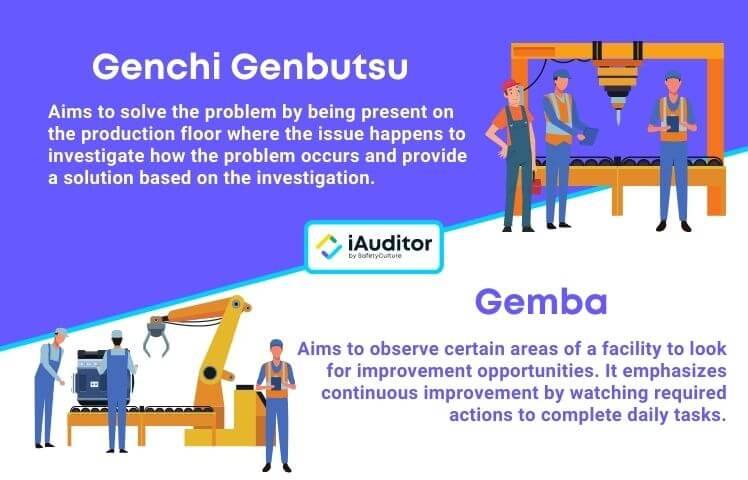What is Genchi Genbutsu?
Genchi Genbutsu is one of the building blocks of continuous improvement which means go and see for yourself. The Japanese term “Genchi” means actual place, while “Genbutsu” means actual thing. It is one of the thirteen pillars of the Toyota Production System and was established to empower people to solve the problem by seeing the issue for themselves.
The objective of the Genchi Genbutsu principle is to emphasize the importance of being on the manufacturing site where production is happening to fully understand the processes, examine the working environment, and determine waste generation. It is a good practice because when problems arise, management can advise the best possible solution immediately.
Advantages of Performing Genchi Genbutsu
The concept of Genchi Genbutsu focuses on facts about what really happened in the production area. It helps organizations to visualize the issue and pinpoint the root cause of the problem in an accurate manner. Performing Genchi Genbutsu can help organizations reap the following benefits:
- have better visibility of the problem;
- solutions can be provided immediately based on the on-site scenario;
- operators have the opportunity to provide their input about the issue;
- opens the communication between management and operators; and
- raise awareness to report issues immediately if it reoccurs in the future.
Genchi Genbutsu vs Gemba

Genchi Genbutsu vs Gemba | SafetyCulture
Genchi Genbutsu is commonly associated with Gemba Walk as they have the same concept to promote continuous improvement. Like Genchi Genbusu, Gemba is also a Japanese term that means “the real place” which is defined as the act of seeing where the actual work happens.
Even though Gemba and Genchi Genbutsu have similar concepts, they differ in their process and implementation. Gemba walk aims to observe certain areas of a facility to look for improvement opportunities and there are no specific issues that the organization was trying to solve. It emphasizes continuous improvement by watching the required actions to complete daily tasks and identify circumstances to implement safety in the workplace.
On the other hand, Genchi Genbutsu is performed when there is an occurrence of an issue that the organization is trying to solve. The exact area on the production floor where the issue happened is where the investigation begins to solve the problem. It helps identify the root cause of the problem by asking relevant questions to operators and walking around the area to investigate.
7 Tips When Performing Genchi Genbutsu
The key to Genchi Genbutsu is the area where the problem occurred. It is important to determine where the analysis should start and what would be the range of the investigation in order to provide a credible solution. Here are some tips when performing Genchi Genbutsu.
- Provide solutions based on first-hand experience;
- Observe and get opinions from operators on how work is executed;
- Conduct surveys and interviews to identify discrepancies based on human understanding;
- Check historical data and other reports regarding procedures and processes;
- Discover errors based on actual processes;
- Check for human or machine errors; and
- Review all aspects of the situation that others may have missed.
Digitize the way you Work
Empower your team with SafetyCulture to perform checks, train staff, report issues, and automate tasks with our digital platform.
Get Started for FreeExample of Genchi Genbutsu in Lean Manufacturing
Genchi Genbutsu principle is performed to identify the root cause of the issue about substandard products being produced. Attending supervisors will go to the production floor and roam around the area. They will investigate the working environment, processes, and equipment or assets to analyze the problem. They can ask around what happened and get the input of operators and check the machinery to discover what the issue might be. After visual check and root cause analysis, they can give an effective solution on how to prevent the production of substandard products.
How SafetyCulture Can Help in Performing Genchi Genbutsu
Implementing Genchi Genbutsu in lean manufacturing is easy, you just have to go into the area and see the issue for yourself, but keeping a record of the incident can be challenging especially if you are using the traditional pen and paper method. It can be cumbersome and prone to damage or loss. With SafetyCulture (formerly iAuditor), an inspection app that can be used through the web or mobile platforms, you can maximize technology, ensure collaboration within the organization, and maintain a secured inspection record. You can also take advantage of the following benefits:
- Create and customize templates
Use our ready-to-use Genchi Genbutsu inspection template or check out our Public Library of free checklist templates. You also have the option to convert your existing PDF, Word Document, Excel, or PowerPoint files into SafetyCulture checklists for free up to 3 files. - Easily log observations
Use your mobile device to access the SafetyCulture app. Record observations and analysis anytime even when you are offline. All data will automatically sync when you are back online. You can also train your employees on effective implementation of best practices. - Capture photos of the incident
With in-app camera access, you can easily capture photo evidence of the incident. You have the option to annotate and add notes to further explain the captured images. - Assign corrective actions
Easily assign actions to appropriate members of the organization to implement immediate rectifications. You can set the priority level and the due date to finish the task. - Access, review, and share reports in real-time
Instantly share your inspection reports with any member of the organization, and you have the option to send reports on the mobile app to specific people via email. All data is automatically stored in the cloud, which you can access anytime, anywhere.
Set up the organization for benchmarking and standardization. Use technology to improve the quality of work and implement continuous improvement in the workplace. Get started with SafetyCulture’s ready-to-use templates.




